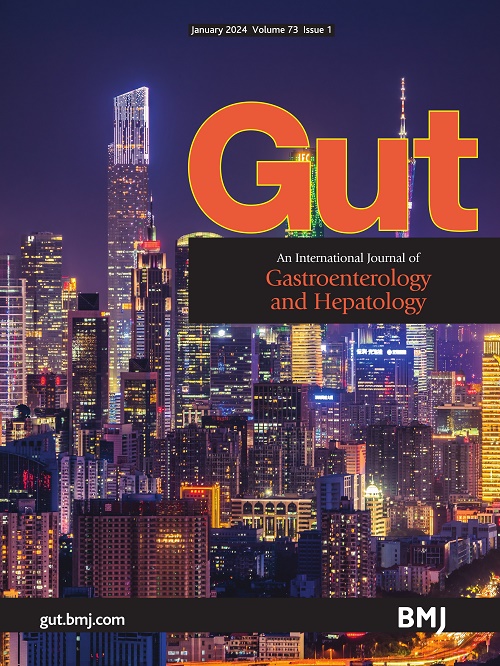Role of CNNM4 in the progression of cholangiocarcinoma: implications for ferroptosis and therapeutic potential
IF 25.8
1区 医学
Q1 GASTROENTEROLOGY & HEPATOLOGY
引用次数: 0
Abstract
Background and objective Cholangiocarcinoma (CCA) is a heterogeneous neoplasm of the biliary epithelium that easily infiltrates, metastasises and recurs. Magnesium disbalance is a hallmark of CCA, with the magnesium transporter cyclin M4 (CNNM4) being a key driver of various hepatic diseases. This study aims to unravel the role of CNNM4 in the initiation and progression of CCA. Design CNNM4 protein and gene expression were assessed in vitro, in vivo and in patients with CCA. Silencing of CNNM4 was effectively achieved by using small interfering RNA (siRNA) or short hairpin RNA in CCA cell lines and GalNAc-conjugated siRNA in a transposon-based CCA mice model. The impact of CNNM4 on tumour cell proliferation, migration and invasion to the lungs was evaluated using the chicken chorioallantoic membrane model. Proteomic analysis was employed to elucidate the underlying molecular mechanisms. Results CNNM4 was upregulated in CCA samples from humans, mice and cell lines. Functional studies demonstrated that CNNM4 deficiency attenuates cell growth, chemoresistance, migration, invasion, cancer stem cell properties and Warburg effect in vitro and in vivo. Proteomic analysis identified nuclear protein 1 as an upstream regulator of CNNM4-induced ferroptosis in CCA, ultimately leading to cell death. The iron chelator deferiprone could reverse the decreased proliferation induced by CNNM4 silencing, while inhibition of the heme oxygenase-1 by zinc protoporphyrin IX affected only the growth of cells with no targeted CNNM4 inhibition, highlighting the specificity of ferroptosis in CNNM4-associated effects. Conclusion This study reveals that increased CNNM4 expression drives CCA progression and malignancy and that its inhibition may be an effective therapeutic strategy to limit proliferation and metastasis in patients with CCA. All data relevant to the study are included in the article or uploaded as supplementary information.CNNM4在胆管癌进展中的作用:对铁下垂的影响和治疗潜力
背景与目的胆管癌(CCA)是一种胆道上皮异质性肿瘤,易浸润、转移和复发。镁失衡是CCA的一个标志,镁转运蛋白周期蛋白M4 (CNNM4)是各种肝脏疾病的关键驱动因素。本研究旨在揭示CNNM4在CCA发生和发展中的作用。设计在体外、体内和CCA患者中评估CNNM4蛋白和基因的表达。在CCA细胞系中使用小干扰RNA (siRNA)或短发夹RNA,在基于转座子的CCA小鼠模型中使用galnac偶联siRNA,可以有效地实现CNNM4的沉默。采用鸡绒毛膜-尿囊膜模型,评价CNNM4对肿瘤细胞增殖、迁移及向肺侵袭的影响。蛋白质组学分析被用来阐明潜在的分子机制。结果CNNM4在人、小鼠和细胞系的CCA样品中表达上调。功能研究表明,CNNM4缺乏在体外和体内减弱细胞生长、化疗耐药、迁移、侵袭、癌症干细胞特性和Warburg效应。蛋白质组学分析发现,核蛋白1是cnnm4诱导的CCA铁凋亡的上游调节因子,最终导致细胞死亡。铁螯合剂去铁素可逆转CNNM4沉默诱导的增殖下降,而原卟啉锌IX对血红素加氧酶-1的抑制仅影响细胞的生长,对CNNM4无靶向抑制作用,突出了铁凋亡在CNNM4相关效应中的特异性。结论CNNM4表达增加可驱动CCA的进展和恶性,抑制其表达可能是限制CCA患者增殖和转移的有效治疗策略。所有与研究相关的数据都包含在文章中或作为补充信息上传。
本文章由计算机程序翻译,如有差异,请以英文原文为准。
求助全文
约1分钟内获得全文
求助全文
来源期刊

Gut
医学-胃肠肝病学
CiteScore
45.70
自引率
2.40%
发文量
284
审稿时长
1.5 months
期刊介绍:
Gut is a renowned international journal specializing in gastroenterology and hepatology, known for its high-quality clinical research covering the alimentary tract, liver, biliary tree, and pancreas. It offers authoritative and current coverage across all aspects of gastroenterology and hepatology, featuring articles on emerging disease mechanisms and innovative diagnostic and therapeutic approaches authored by leading experts.
As the flagship journal of BMJ's gastroenterology portfolio, Gut is accompanied by two companion journals: Frontline Gastroenterology, focusing on education and practice-oriented papers, and BMJ Open Gastroenterology for open access original research.
 求助内容:
求助内容: 应助结果提醒方式:
应助结果提醒方式:


